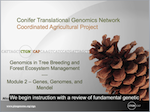Authors:
Fikret Isik, North Carolina State University; Heather L. Merk, The Ohio State University
Introduction
This module is organized in four sections. The first section focuses on best linear unbiased prediction (BLUP) of breeding values using a numerical relationship matrix, called the A matrix. This matrix is usually derived from pedigrees of individuals. The relationships are sometimes called additive genetic covariances. The second section focuses on incorporation of markers in models and the various approaches to marker aided selection we have introduced in previous modules. The third section addresses a key issue related to the use of markers for selection, namely, how missing genotypes are inferred or imputed so that breeding values can be calculated. The final section focuses on the realized genetic matrix for G-BLUP. The genetic relationship matrix based on the markers is called the G matrix, and BLUP analysis based on the G matrix is called G-BLUP.
Module 14 — Using Markers to Predict Breeding Values
See other Conifer Genomics Modules
You can also watch the video on YouTube
References Cited
- Dekkers, JCM, and F. Hospital. 2002. Multifactorial genetics: The use of molecular genetics in the improvement of agricultural populations. Nature Reviews Genetics 3: 22-32. (Available online at: http://dx.doi.org/10.1038/nrg701) (verified 19 Apr 2012).
- Falconer, D. S., and T.F.C. Mackay. 1996. Introduction to quantitative genetics 4th edition. Longman, Essex, England.
- Fernando, R. L., and M. Grossman. 1989. Marker assisted selection using best linear unbiased prediction. Genetics Selection Evolution 21: 467–477.
- Forni, S., I. Aguilar, I. Misztal. 2011. Different genomic relationship matrices for single-step analysis using phenotypic, pedigree and genomic information. Genetics Selection Evolution 43: 1. (Available online at: http://dx.doi.org/10.1186/1297-9686-43-1) (verified 19 Apr 2012).
- Gengler, N., P. Mayeres, and M. Szydlowski. 2007. A simple method to approximate gene content in large pedigree populations: Application to the myostatin gene in dual-purpose Belgian Blue cattle. Animal 1: 21-28. (Available online at: http://dx.doi.org/ 10.1017/S1751731107392628) (verified 19 Apr 2012).
- Mrode, R. A. 2005. Linear Models for the Prediction of Animal Breeding Values. 2nd edition, CABI, Oxfordshire, United Kingdom.
- VanRaden, P. M. 2008. Efficient methods to compute genomic predictions. Journal of Dairy Science 91: 4414-4423. (Available online at: http://dx.doi.org/10.3168/jds.2007-0980) (verified 19 Apr 2012).
- Weller, J. I., M. Shlezinger, and M. Ron. 2005. Correcting for bias in estimation of quantitative trait loci effects. Genetics Selection Evolution 37: 501-522. (Available online at: http://dx.doi.org/10.3168/jds.2007-0980) (verified 19 Apr 2012).
External Links
- Dekkers, J. Genomic selection in livestock: Introduction and motivation [Online short course notes]. 2010 Animal Breeding & Genetics Short Courses, Iowa State Unversity. Available at: http://www.ans.iastate.edu/stud/courses/short/2010short.html (verified 19 Apr 2012).
- Gilmour, A. R., B. J. Gogel, B. R. Cullis, and T. Thompson. 2009. ASReml user [Online user guide]. VSN International Ltd. Available at: http://www.vsni.co.uk/downloads/asreml/release3/UserGuide.pdf (verified 19 Apr 2012).
Additional Resources
- Hayes, B. QTL mapping, MAS, and genomic selection. [Online short course notes]. 2007 Animal Breeding & Genetics Short Courses, Iowa State Unversity. Available at: http://http://www.ans.iastate.edu/stud/courses/short/2007/) (verified 19 Apr 2012).
- Meuwissen, T.H.E., B. J. Hayes, and M. E. Goddard. 2001. Prediction of total genetic value using genome wide dense marker maps. Genetics 157: 1819-1829.
Cite This Learning Module
- Isik, F. Using markers to predict breeding value. [Online Learning Module]. Genomics in Tree Breeding and Forest Ecosystem Management, Conifer Translational Genomics Network. eXtension Foundation. Available at https://plant-breeding-genomics.extension.org/using-markers-to-predict-breeding-values:-conifer-genomics-module-14/ (verified April 22, 2013).
Author Contributions
- Fikret Isik developed the learning module content.
- Heather Merk developed the webpage.
Funding Statement
Support for the Conifer Translational Genomics Network project and the development of the teaching modules hosted here was provided by the USDA/NRI CSREES Plant Genomics Coordinated Agricultural Project (CAP) Award # 2007-55300-18603, the USDA/NIFA AFRI Applied Plant Genomics CAP Award #2009-85606-05680 and the USDA Forest Service. Development of this page was supported in part by the National Institute of Food and Agriculture (NIFA) Solanaceae Coordinated Agricultural Project, agreement 2009-85606-05673, administered by Michigan State University. Any opinions, findings, conclusions, or recommendations expressed in this publication are those of the author(s) and do not necessarily reflect the view of the United States Department of Agriculture.
Attachments:
OLM_14_Markers_Predicting_BVFINAL_30March2012.pdf (878.37 KB)
PBGworks 1255

